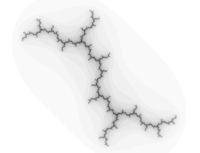Dendrite (mathematics)

Okay kiddo, let’s talk about dendrites in math.
Imagine you have a tree in your backyard. The tree has lots of branches and leaves that grow out from the trunk. You know how some trees have a really complicated pattern of branches and leaves that almost look like a maze? That’s sort of what a dendrite in math looks like.
In math, a dendrite is a type of geometric shape that is made up of lots of branches and sub-branches. It starts with a central point (kind of like the trunk of the tree), and then branches out in different directions. Each branch can then split into more branches, and those branches can split into even more branches, and so on.
It might help to picture it like a lightning bolt. When lightning strikes, it creates a path of electricity that branches out in different directions. A dendrite in math has a similar branching pattern, but instead of electricity, it’s made up of lines and curves.
Dendrites can be found in lots of different areas of math, like geometry, topology, and fractal geometry. They’re used to help describe complex shapes and patterns, and can be really helpful in understanding how things are connected to each other.
But don’t worry kiddo, you don’t need to be a math genius to understand dendrites. Just remember that they’re like a complicated tree or lightning bolt shape that can help us make sense of complex patterns in math.
Imagine you have a tree in your backyard. The tree has lots of branches and leaves that grow out from the trunk. You know how some trees have a really complicated pattern of branches and leaves that almost look like a maze? That’s sort of what a dendrite in math looks like.
In math, a dendrite is a type of geometric shape that is made up of lots of branches and sub-branches. It starts with a central point (kind of like the trunk of the tree), and then branches out in different directions. Each branch can then split into more branches, and those branches can split into even more branches, and so on.
It might help to picture it like a lightning bolt. When lightning strikes, it creates a path of electricity that branches out in different directions. A dendrite in math has a similar branching pattern, but instead of electricity, it’s made up of lines and curves.
Dendrites can be found in lots of different areas of math, like geometry, topology, and fractal geometry. They’re used to help describe complex shapes and patterns, and can be really helpful in understanding how things are connected to each other.
But don’t worry kiddo, you don’t need to be a math genius to understand dendrites. Just remember that they’re like a complicated tree or lightning bolt shape that can help us make sense of complex patterns in math.
Related topics others have asked about:
